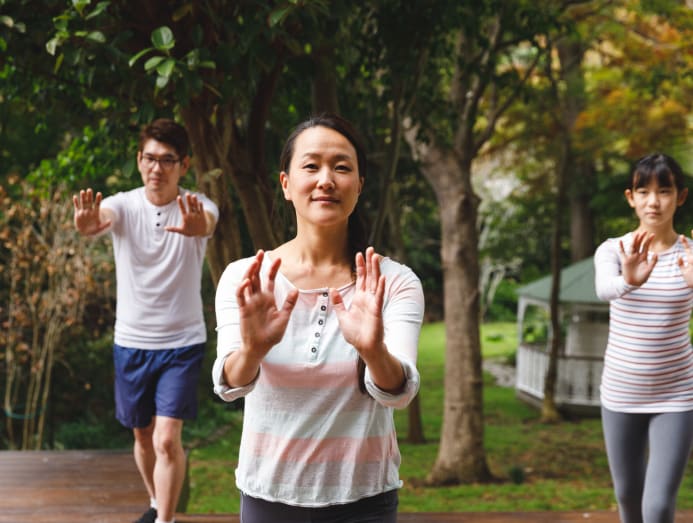
(Photo: iStock/FangXiaNuo)
Practising being present is another key component in qigong and that practice, when extended to your gym workout, can also help with injury prevention. “A lot of people who do weight-lifting feel strain in the back. That means they’re not focusing on lifting through with their legs. Or you’re jogging but all you feel is the slamming of your feet and the Airpods in your ears.”
The ability to hone mental focus aside, you’ve got to admit: Qigong doesn’t quite entice the younger crowd because it looks too easy. “Many people think that qigong is all airy fairy, and it’s just waving your arms around,” said Tan.
Just try holding a position for three to five minutes. You might be wobbling, teetering or feeling the strain in certain muscles.

(Photo: iStock/Wavebreakmedia)
But for the qigong practitioner who has the right form and feels perfectly balanced, holding the position is not a problem for any extended duration, he said. “You’re stable and not constantly adjusting and asking ‘where’s my centre of gravity, where is my left or right leg?’ It just feels comfortable and you’re naturally resting your weight on the ground.”
In fact, the older you are when you take up qigong, the fewer benefits you can enjoy because you’re limited by what you can do physically, said Tan. “When you’re much older, like in your 60s or 70s, what I offer has to be very much watered down.”
“When someone in his 30s picks up qigong and continues practising into his 60s, his movements are going to be very different from someone who started in his 50s. The person who started early will also walk more sure-footedly and look more alert than the average 60-year-old”.
TRY QIGONG YOUSELF
Tan suggests these three moves that you can try without the presence of a teacher. “They can be done in 10 minutes, with each movement taking about three minutes,” he said.
The moves aren’t meant to be a workout per se but more to refresh yourself after a stressful day, so you can spend time with your family, head for the gym or go for a run in a not-so-agitated state, he said.
1. Pushing the sky
This move stretches and opens up the muscles and tissues in the front of the body that get bunched up from a day of sitting.
To perform: With your arms fairly straight, interlock your fingers below the navel and slightly bend your knees. Inhale as you straighten your knees and stand tall, lifting your arms and flipping your palms overhead. Exhale and bring your arms down in an arc from the sides as you bend your knees. Perform 10 repetitions.
2. Squatting and rising
This move works the legs and opens the hips, and is great for when you’ve been sitting all day. It helps to redistribute energy from the head to the legs.
To perform: Stand with feet wider than shoulder-width apart and feet pointed to the front. Straighten and raise your arms to the sides in line with your shoulders. Exhale as you squat down and inhale as you stand up. Squat only to the depth your knees allow you and keep your arms up to the sides for the duration of this move. Perform 10 repetitions.
3. Gathering the qi
This is an important closing move after a qigong session. It helps to gather your energy back into your body and make it feel refreshed. This move can also be performed after sporting activities or stressful encounters.
To perform: Stand with your knees slightly bent and arms touching the side of your thighs. Inhale and raise your arms to the sides in a big arc overhead. Exhale and lower your hands down the front of the body. Perform 10 to 15 repetitions or as long as you need to cool down.
Alternatively, you can find Tan through SgFitFam, a fitness service provider, for one-on-one sessions (from S$100). Or you can join his weekly one-hour classes (S$25 per person) which he conducts at a sheltered HDB common space in Tampines in groups of no more than 15. You can also join him at home via his Zoom sessions.
“I prefer to teach outdoors. In qigong, we’re trying to build this vital energy in the body. When training in nature, you get the support of nature’s qi, which can help one’s practice to develop faster and also enjoy more health benefits.”
And might we add, you don't have to dress like Shang-Chi to practise qigong.
Source: CNA/bk






 Reply With Quote
Reply With Quote